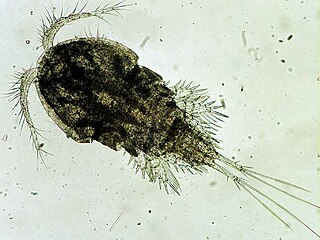
Tantulocarida is a highly specialised group of parasitic crustaceans that consists of about 33 species, treated as a class in superclass Multicrustacea. They are typically ectoparasites that infest copepods, isopods, tanaids, amphipods and ostracods.

The Cyclopoida are an order of small crustaceans from the subclass Copepoda. Like many other copepods, members of Cyclopoida are small, planktonic animals living both in the sea and in freshwater habitats. They are capable of rapid movement. Their larval development is metamorphic, and the embryos are carried in paired or single sacs attached to first abdominal somite.

Calanus is a genus of marine copepod in the family Calanidae. The genus was split in 1974, with some species being placed in a new genus, Neocalanus. The following species are recognised:
Paradiaptomus excellens is a species of copepod in the family Diaptomidae. It is endemic to South Africa.
Paradiaptomus simplex is a species of copepod in the family Diaptomidae. It is endemic to South Africa.
Speleophria is a genus of marine copepods in the family Speleophriidae. It contains the following species:

Acartiidae is a family of calanoid copepods distinguishable by the rostral margin not being extended. They are epipelagic, planktonic animals, not being found below a depth of 500 metres (1,600 ft). There are over 100 described species distributed throughout the world's oceans, mainly in temperate areas.
Paralubbockia longipedia is a species of copepod, and the only member of the family Paralubbockiidae. The family is characterised by the ventral position of the fifth legs, the possession of a separate maxillary palp, and the form of the endopods of the legs and antennae. The closest relatives of Paralubbockia are the family Oncaeidae. Initially placed among the Poecilostomatoida, Paralubbockia is now considered part of the Cyclopoida.
The Chitonophilidae are a family of parasitic copepods, with these genera:
Centropagidae is a family of copepods in the order Calanoida. Its members are particularly known as plankton in coastal waters and in fresh water in Australia and southern South America. They are also found on subantarctic islands and in lakes in Antarctica.
Gaussia is a genus of copepods. The genus contains bioluminescent species. It is a "characteristic genus of the mesopelagial", occurring at depths of 0–3,000 metres (0–9,843 ft). The genus Gaussia contains the following species:
Geoffrey Allan Boxshall FRS is a British zoologist, and Merit researcher at the Natural History Museum, working primarily on copepods.
Speleophriidae is a family of copepods, comprising seven genera. All are restricted to anchialine caves, with the exception of Archimisophria, which is found in the hyperbenthos of the depths of the Atlantic Ocean. The genera are:
Nicothoe is a genus of copepods, containing the following species:
Nicothoidae is a family of copepods, containing the following genera:

Euaugaptilus is a genus of copepods. The genus contains bioluminescent species.
Augaptilidae is a family of copepods.

Lepeophtheirus pectoralis is a species of parasitic copepod from the northeast Atlantic Ocean, and the type species of the genus Lepeophtheirus. It is a parasite of flatfish, with the European flounder, the plaice, and the dab as the most frequent hosts. It feeds on the mucus, skin, and blood of the fish, with egg-producing females infecting the pectoral and pelvic fins of the host, while immature individuals and males are found on the rest of the body.

Hutchinsoniella macracantha is a species of crustacean known as a horseshoe shrimp. It is the only species in the genus Hutchinsoniella and was first described in 1955 by Howard L. Sanders, having been discovered in Long Island Sound; they were the first example of a new class of crustacean that was given the name Cephalocarida.
Asterocheres lilljeborgi is a species of copepod in the family Asterocheridae. It is found in the British Isles and Scandinavia where it is a semi-parasite of starfish. First described as Asterocheres lilljeborgi in 1859 by the Norwegian marine biologist Jonas Axel Boeck, it is the type species of the genus.






